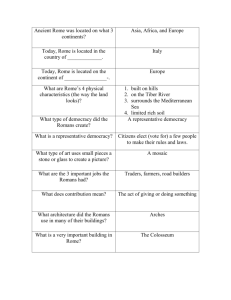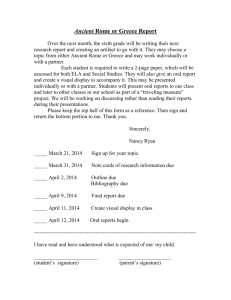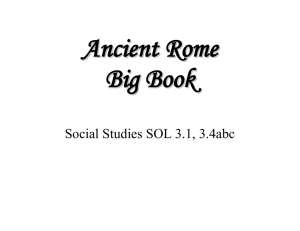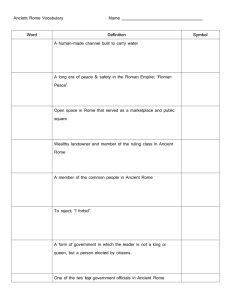Ancient Rome Museum Walk
advertisement
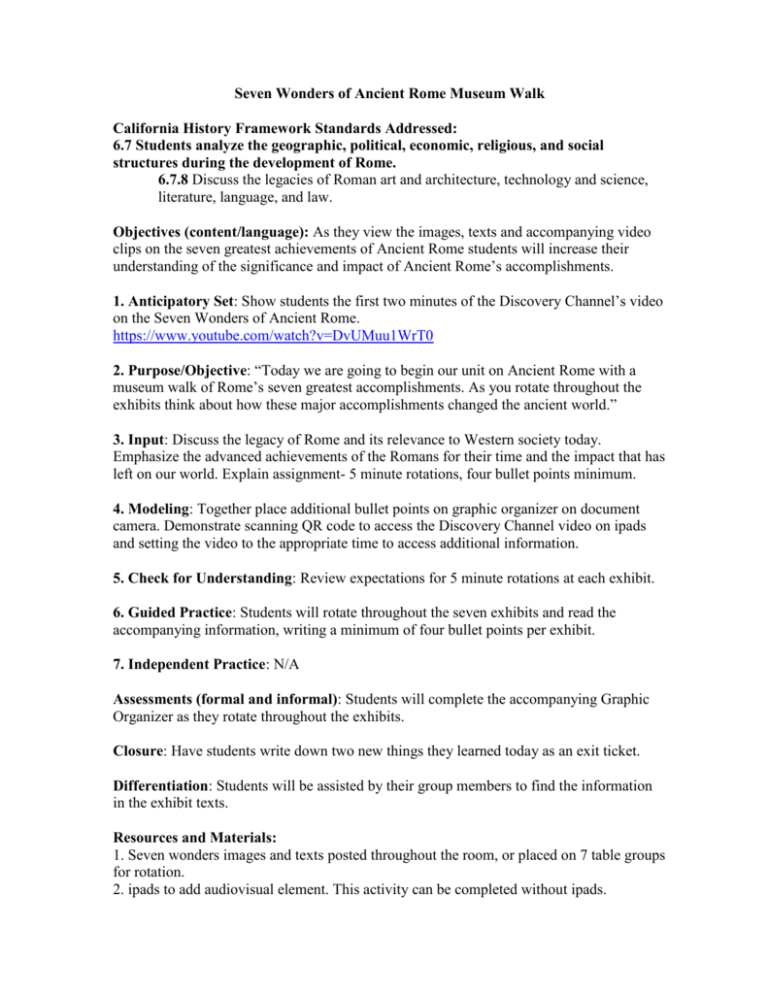
Seven Wonders of Ancient Rome Museum Walk California History Framework Standards Addressed: 6.7 Students analyze the geographic, political, economic, religious, and social structures during the development of Rome. 6.7.8 Discuss the legacies of Roman art and architecture, technology and science, literature, language, and law. Objectives (content/language): As they view the images, texts and accompanying video clips on the seven greatest achievements of Ancient Rome students will increase their understanding of the significance and impact of Ancient Rome’s accomplishments. 1. Anticipatory Set: Show students the first two minutes of the Discovery Channel’s video on the Seven Wonders of Ancient Rome. https://www.youtube.com/watch?v=DvUMuu1WrT0 2. Purpose/Objective: “Today we are going to begin our unit on Ancient Rome with a museum walk of Rome’s seven greatest accomplishments. As you rotate throughout the exhibits think about how these major accomplishments changed the ancient world.” 3. Input: Discuss the legacy of Rome and its relevance to Western society today. Emphasize the advanced achievements of the Romans for their time and the impact that has left on our world. Explain assignment- 5 minute rotations, four bullet points minimum. 4. Modeling: Together place additional bullet points on graphic organizer on document camera. Demonstrate scanning QR code to access the Discovery Channel video on ipads and setting the video to the appropriate time to access additional information. 5. Check for Understanding: Review expectations for 5 minute rotations at each exhibit. 6. Guided Practice: Students will rotate throughout the seven exhibits and read the accompanying information, writing a minimum of four bullet points per exhibit. 7. Independent Practice: N/A Assessments (formal and informal): Students will complete the accompanying Graphic Organizer as they rotate throughout the exhibits. Closure: Have students write down two new things they learned today as an exit ticket. Differentiation: Students will be assisted by their group members to find the information in the exhibit texts. Resources and Materials: 1. Seven wonders images and texts posted throughout the room, or placed on 7 table groups for rotation. 2. ipads to add audiovisual element. This activity can be completed without ipads. Ancient Wonder of Notes Rome Build by Emperor Circus Maximus Stadium ______________________________________________ Could hold ______________________________________ people Built by _______________________________________ Trajan’s Forum _______________________________ long network of aqueducts Aqueduct Built by Baths of ________________________________________________ Caracalla First road was _____________________________________ built by censor _____________________________________ Roman Roads A network of _____________________________________ miles of roads were built Rebuilt by emperor _____________________________ Pantheon Could hold over ____________________________________________ Colosseum people Building begun by emperor ________________________________________________ _ Circus Maximus This stadium is the largest arena ever constructed! The stadium could hold 250,000 people on four seating tiers. It is twice the size of the largest stadium existing today, and has been an inspiration to modern sports stadiums worldwide. It was most famously used for chariot races, but also hosted beast and gladiator fights. In a standard chariot race, twelve chariots would complete seven laps around the 300 meter dividing barrier in the center of the stadium. These races were so dangerous more than 50 charioteers died every year, but those that survived were treated like celebrities. Emperor Trajan commissioned the stadium to be built in 103 AD out of stone and concrete after an earlier wooden arena burnt to the ground. The Romans were the first civilization to use concrete, which allowed them to build strong and tall buildings quickly. The use of concrete allowed the structure to stand for 500 years. Want to learn more? Watch the Discovery Channel’s Seven Wonders of Ancient Rome video beginning at: 2:00 minutes Trajan’s Forum There were five forums in ancient Rome, but Trajan’s forum was larger than all the other forums put together. It had a large piazza (open meeting place) in the center, surrounded by arched openings decorated with statues of Trajan. It was made of marble and bronze with a triumphal arch, triumphal column, and a large statue of Trajan on a horse. It contained Latin and Greek libraries, a law court, a temple dedicated to Trajan himself and the first world’s shopping center, Trajan’s Market. Trajan’s Market was a five story shopping complex built to hold 150 shops including bars and take-out shops. The shops offered goods from all over the world. Ancient Romans would go here to socialize, eat, shop, and relax just like we do in our malls today. Want to learn more? Watch the Discovery Channel’s Seven Wonders of Ancient Rome video beginning at: 10:45 minutes Aqueducts Rome couldn’t survive without fresh water. It needed it for drinking, irrigation, and private and public baths and latrines. The Romans found a way to bring fresh water from the natural springs several miles outside the city to the people of Rome using aqueducts. At the peak of Roman engineering, the Romans had a system of over 400 miles of underground and above ground channels that provided 230 million gallons of water through 11 aqueducts to Rome’s 1 million people. When the water arrived it was held in three large cisterns: one for the general public, one for public baths, and one for private households that paid a water tax. This was a luxury for the rich and helped cover the costs of providing water for everyone. The aqueducts carried water using gravity and a particular degree of incline. Some of the water tunnels Romans built through hills were constructed so well that they are still in use today! Drinking water passed through several purification tanks to make it safe for consumption. Romans used arches for the above ground portions of the aqueducts because building tall solid walls was too expensive and unstable. However, the arches also became unstable above 68 feet. When they had to build even higher, the Romans constructed a second or third tier of arches on top of the first. They also discovered a waterproof form of cement they used when aqueducts had to pass through rivers or bodies of water. Want to learn more? Watch the discovery channel’s video beginning at: 14:00 minutes Baths of Caracalla One of Rome’s most ruthless tyrants was the Emperor Caracalla. In his desire to make a lasting name for himself he undertook to finish the enormous bath complex begun by his father, Emperor Septimius Severus in 206 AD. Though there were already over 900 public bath complexes throughout Rome, none compared to the elaborate baths of Caracalla. The complex spread over almost 30 acres and could hold up to 1,600 bathers at one time. In addition to having beautiful gardens, libraries, beauty parlors, cafes, shops, and a temple, the baths had beautiful mosaics, statues, and sculptures decorating the complex. The central space contained several different types of baths. There were baths of different temperatures including a Frigidarium, a cold water bath, a Tepidarium, a tepid water bath, and a Caldarium, a hot water sauna. There were also two gymnasiums and an Olympic size circular swimming pool with bronzepanel mirrors above it to reflect sunlight on the pool area. Though the baths were luxurious for the bathers, the slaves that worked beneath the structure suffered. They had to man over 50 furnaces to heat the baths, requiring more than 2,000 tons of wood. The baths required over 2 million gallons of hot and cold water. A large system of terracotta pipes moved freshwater in and wastewater out. Some pipes were hidden in the walls to channel hot air from the beneath the baths to heat the rooms above. Though Caracalla succeeded in building the most lavish bath complex in Rome, he was not able to enjoy his accomplishment long. His bodyguard assassinated him one year after the baths were opened to the public. The baths, however, remained in use for 300 years. Want to learn more? Watch the discovery channel’s video beginning at: 24:50 minutes Roman Roads The Romans used roads to connect their vast empire, facilitate trade, and move their armies. They build a large network of roads throughout their empire with Rome at its center, facilitating travel from Rome to far-away provinces. This lead to the popular expression, “All roads lead to Rome”. The Romans were excellent road builders. The first Roman road was called the Via Appia, build by the Roman censor Appius Claudius Caecus, specifically to transport troops to Apulia in 312 BC. Until this time roads were just enhanced ancient paths designed to avoid rivers and hills. They didn’t provide for efficient transport of vast armies like the Romans wanted. Within 200 years of the first road’s construction, the Romans built a network of over 50,000 miles of paved roads throughout their empire. The Romans carefully planned their roads. Civil engineers used a surveying system to plan the path of their roads in straight lines. This surveying technique didn’t allow for turns and bends, so Romans cut through any natural obstacles in their way. Engineers devised a way to make the roads last. First they dug a trench and laid sand and small stones in it. Then they laid a layer of gravel and mortar, and covered these layers with interlocking pavement stones to make the surface flat. They also placed mile markers every 1,000 steps and engraved them with the distance to the next town. The Roman roads were built so well some parts of it are still used today. One famous section of the Via Appia, called the Ancient Appian Way, stands as a testament to the durability of Roman road construction. It is over 2,300 years old. Want to learn more? Watch the discovery channel’s video beginning at: 26:00 min Pantheon The Pantheon standing today was built by the Emperor Hadrian after two previous Pantheons burnt down. It is one of Rome’s great architectural accomplishments, and is the best-preserved Roman monument standing today. Its construction has amazed and inspired architects throughout the centuries. Renaissance architects such as Brunelleschi and Michelangelo studied the Pantheon for inspiration on designing the domes of Santa Maria del Fiore and St. Peter’s Basilica in Florence. The style of the Pantheon can be seen in many of our government buildings, universities, and libraries today. The front space of the Pantheon, known as the Portico, is supported by 16 granite columns imported from Egypt, each weighing 60 tons. The interior is a perfect circle, topped with a 142 ft diameter dome with a 33 ft wide oculus (open hole) at its center. The dome of the Pantheon is considered an engineering masterpiece. It is double the size of any dome built before it, and remained the largest until the Renaissance era. It is still the largest dome without reinforced concrete. To avoid the massive dome collapsing under its own weight Roman engineers made it 21 ft thick at its base and gradually reduced it to 4 feet thick around the oculus, which also serves to lighten the weigh of the dome and allow light and ventilation into the temple. The Pantheon was an ancient temple dedicated to all gods. Though we don’t know what name the ancient Romans used for it, we call it the Greek word Pantheon, “pan” meaning “all”, and “theon” meaning “gods”. In the 7th century, it was converted into a church. Its continued use and maintenance over the centuries by various religious orders helped to preserve it over 2,000 years. Want to learn more? Watch the discovery channel’s video beginning at: 35:15 minutes Colosseum The Emperor Vespasian began the work on the Colosseum in 72 AD, and his son, Titus, oversaw its completion in 80 AD. It was the biggest amphitheater in Ancient Rome. The design of the Colosseum allowed 60,000 spectators to flow in and out of its 75 entrances. The arches allowed for plenty of open space and the use of concrete kept the structure strong. Romans made concrete out of volcanic ash, lime, and a mixture of rubble. Stone was used on the outer wall. The Colosseum had gigantic awnings above the arena to shade the audience from the sun. Beneath the arena floor there were tunnels and rooms that held stage sets, gladiators, and wild beasts. These could be lifted up to the arena floor using ramps and lifts. Emperor Titus inaugurated the Colosseum with 100 days of gladiator matches, executions, animal hunts, and reenactments of famous battles. Want to learn more? Watch the discovery channel’s video beginning at: 38:50 minutes Information taken from: http://www.documentary24.com/seven-wonders-ofancient-rome-roman-empire--1524/ Circus Maximus Trajan’s Forum Aqueducts Pont du gard, France Nerja, Andalusia, Spain Baths of Caracalla Roman Roads The Appian Way Pantheon Colosseum





